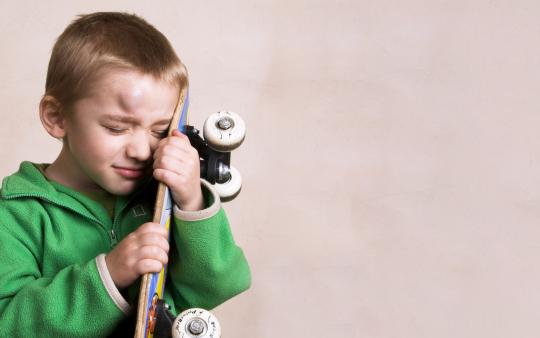As toddlers get inquisitive and start exploring their environments, falls become a regular part of life. Maybe they tumble off the sofa, or slip on slick floors while cruising around. Whatever the cause, a bump on the head is always a source of stress. For older kids, injuries from sports like football, soccer, and baseball have varying levels of severity. In my office, many parents wonder if common childhood head injuries lead to long-term damage. The good news is most kids heal up just fine.
Researchers from Australia tracked a small group of children with varying degrees of head injury over ten years. The results were recently released and found that mild concussion did not delay development, fine motor skills, learning and memory, or cause abnormal changes to brain imaging. The study discovered an “injury threshold,” where children with minor injuries fared well. More severe injuries—usually those sustained from car accidents and contact sports—can harm the brain in the long term. So how do we know when a concussion is above or below this threshold?
Common symptoms of concussion
There are a number of telltale symptoms that help to clarify this issue. Common concussion symptoms include headache, confusion, dizziness, and nausea, possibly with vomiting. More concerning symptoms to watch out for include drowsiness with passing out, a worsening headache, slurred speech, weakness, and repeated vomiting episodes. If your child has not lost consciousness, is alert and interactive, and otherwise acting like their normal self, they likely sustained a minor head injury.
To play it safe, having a check-up with your family physician is always a good idea. Your doctor can perform a concussion evaluation to determine severity and advise you on the next steps. For the most part, treatment involves lifestyle and environmental medicine. Curbing screen use, staying hydrated, getting healthy sleep, and balanced nutrition are all key factors. To support recovery, avoid sugars, trans fats, and processed foods. Most importantly, make sure your doctor clears your child before returning to sports participation, as a repeat injury is much more serious.
There’s quite a bit of attention currently on the effects of repetitive concussion, which can lead to post-concussive syndrome and Chronic Traumatic Encephalopathy (CTE). Although CTE is usually diagnosed in adult athletes, incidence among adolescents is on the rise. CTE is most often linked with football, and occurs when the brain repeatedly sustains mild to moderate concussive impact, leading to accumulative micro-damage. Behaviour changes like irritability, aggression, and difficulty with focus are the most common symptoms. For a detailed look at this condition, check out the eye-opening book When Brains Collide, by Michael Lewis. Conventional medical treatment options are somewhat limited, and may include medication management and rehabilitation. This article takes a look at a novel treatment that shows promise: Hyperbaric Oxygen Therapy (HBOT).
Hyperbaric oxygen therapy
Hyperbaric therapy works with pressure as a medical tool (hyper meaning increased, and baric referring to atmospheric pressure). In chemistry, Henry’s Law tells us that the amount of gas (oxygen) dissolved into a fluid (blood) increases with pressure. By ramping up atmospheric pressure to varying levels, hyperbaric chambers increase oxygen supply and delivery around the body. Increased oxygen triggers latent stem cells for tissue repair and healing, while improving micro-circulation.
Treatment involves physically getting inside a pressurized chamber for an hour or so, with repeat sessions for a certain number of days. At sea level, around 0.3 mL of oxygen will dissolve into 100 mL of serum. At 1.3 atmospheres, HBOT increases oxygen by a factor of 7 times, hyper-oxygenating body tissues. By pulsing tissue oxygenation, HBOT activates various healing pathways, promoting stem cell activation in bone marrow, lowering inflammation, enhancing blood vessel growth, and improving immune health.
The concept of pressure as medicine dates back several centuries! In 1662, a British physician created an airtight chamber that used valves and bellows to increase ambient pressure. This prototype was called a “domicilium” and was later adapted in the 1800s as a medical treatment by Dr. Paul Bert, a French engineer and physician. Hyperbaric chambers caught on in North America during the 1920s, and the US Navy started research on medical applications. Beneficial effects for decompression sickness and wound healing were subsequently discovered. To this day, hospitals around the world rely on hyperbaric chambers to treat a variety of health conditions. Steel-sided chambers create higher pressures for enhanced wound healing, acute anemia recovery, and the bends, or decompression sickness. Soft-sided chambers create lower pressures ranging from 1.3 to 1.5 atmospheres and show promise for treating mild traumatic brain injury (mTBI) in emerging research. Currently, HBOT treatment for head injury is considered off-label (approved but not for the proposed use) by the FDA.
Evidence for Hyperbaric Concussion Treatment
For post-concussive syndrome and CTE specifically, evidence supporting the safety and efficacy of HBOT is on the rise. With brain injury, there is essentially a bruise inside the cranium, leading to swelling that causes symptoms such as confusion, vomiting, and light sensitivity. Mild injury does not cause structural damage that can be seen on MRI or CT scans. Fortunately, pathological changes from CTE and mTBI can be detected using SPECT neuroimaging, a unique type of imaging used to monitor changes with HBOT treatment that assesses changes in blood flow and creates a 3D brain map. Over the course of a few decades, physicians realized that high pressure treatments created too much stress and risked further damage after mTBI. However, limited treatments with lower pressure chambers led to positive outcomes, including enhanced healing time and improved long term symptoms.
In research, the typical HBOT protocol is 40 hours at 1.3–1.5 atmospheres over 1 month, which is compared to baseline. Improvement is tracked through patient questionnaires, cognitive tests, and physical exams, along with SPECT monitoring. In 2012, researchers at the University of Louisiana School of Medicine embarked on a study of 16 military personnel diagnosed with post-concussion syndrome. Dr. Paul Harch, a leader in hyperbaric medicine, pioneered this project. All 16 subjects completed a series of tests and SPECT scans before starting. After one month, there was marked improvement in concussive symptoms, cognitive tests, and self-reported quality of life. SPECT imaging discovered increases in healthy cerebral blood flow for most participants. A larger scale study at Tel Aviv University in 2013 tracked 56 patients with mTBI. Scientists used a similar approach to monitor changes, including physical examination and SPECT imaging. In this study, participants underwent 40 sessions, spread over two months, and experienced brain healing and repair along with improvements on SPECT imaging as well.
Hyperbaric Safety for Kids
Common side effects with HBOT include ear pain and reversible lung spasm. At low pressures (between 1.3 and 1.5 atmospheres), HBOT is safe with appropriate medical screening prior to use. Before a session, a provider should screen for allergies, sinusitis, hypertension, and respiratory illness. A simple exam and set of vitals help uncover any conditions that will make it difficult to clear the ears. The pressure sensation is similar to going up in an airplane, and the same tricks, like chewing gum and yawning, help relieve pain. At low pressures, hyperbaric medicine is safe for children under qualified medical supervision.
Remarkably, the human brain is one of our most fragile organs, considering its key role in maintaining all body functions. Impacts to the cranium can certainly accumulate and cause damage over time. Fortunately, the brain also exhibits resiliency, and can heal and repair like other parts of the body, challenging the outdated view of the brain as static, with loss of function being a permanent sentence. Like most things in science, our understanding has evolved. Emerging research into neuroplasticity reveals the brain’s ability to change continuously throughout the lifespan. Neural pathways and synapses shift and heal based on behaviour, environment, and neural processes, allowing the brain to recover function over time. With more serious injury, developing a holistic treatment plan with your care team is the way to go, which may include advanced therapies like hyperbaric oxygen. Further research into childhood post-concussive syndrome is warranted to get a better sense of the value of HBOT. For now, there is promising evidence pointing to a therapeutic utility.
You may also enjoy: How to Heal Naturally from a Traumatic Brain Injury and Do Environmental Toxins Cause Brain Damage in Children?
For further reading visit ecoparent.ca/extras/SUM20.






